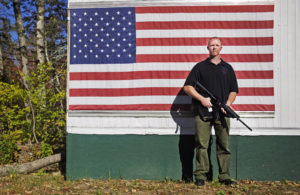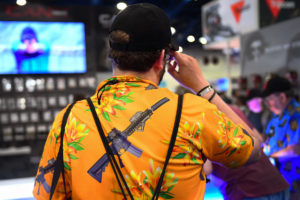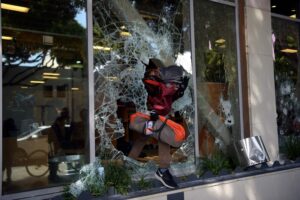The 25 years since the Columbine massacre have given us many occasions — other massacres, alas — to invoke it. But this repetition has had the strange effect of dimming and narrowing our sense of what “Columbine” was in its details. From reading up on the tragedy in recent weeks, I learned that my own sense of Columbine had dimmed and narrowed very much over those 25 years. For me, “Columbine” had become a sort of placeholder, a vague signifier for the few things it has in common with all the new massacres that bring it to speech, rather than the name of something that, when it happened, was catastrophically unique. I’m not alone. People I’ve told the things I’m relearning have likewise received these old facts as fresh revelations. The details of Columbine are sad and shocking, in other words, but we’ve forgotten them anyway. They are worth remembering.
Columbine was not unprecedented. I knew that. Armed people had shot up American schools before, and Eric Harris and Dylan Klebold, the Columbine killers, may have been inspired by some of these killings. But their truer inspirations were not shooters at all. They were larger events of mass mayhem and death. In an online journal Harris sketched his ambition to create something “like the LA riots, the Oklahoma bombing, WWII, Vietnam”, and various apocalyptic video games “all mixed together”. Accordingly, he and Klebold conducted a careful study of their school’s cafeteria, to learn when it would be most densely packed with students (11:17am, they determined). They built several large propane bombs, timed them to explode at this peak moment, and, on the morning of their attack, carried them into the cafeteria, using the lunch-hour busyness as cover for their unusual lugging and dropping of heavy duffle bags in a lunch room.
So Harris and Klebold murdered 12 students and a teacher in their attack, and this was the deadliest school shooting in American history, at the time. But their plan was to kill many more — “at least four hundred”, Harris said. Given the size of the bombs he made, and given the number of kids in the lunchroom at 11:17am of April 20, 1999, he may have hit or even exceeded his number, if his poorly made bombs had actually gone off. The Columbine massacre is notorious as a school shooting, then, but it was also, and perhaps more consequentially, a failed bombing.
Beside its failed-bombing aspect, another core fact of Columbine that had faded in my memory is that its mastermind and driving spirit was a figure of evil so total and so extreme that, were he a character in a cartoon, you’d think him too cartoonish. Unlike many other school-shooters and mass-shooters both before and after Columbine, Eric Harris was neither abused nor delusional. He was smart and had a decent number of friends and was somewhat attractive to girls. He was fairly well-raised by a doting mother and an ex-military father — who was kind of a jerk, apparently, but hardly a tyrant to his two sons. Although early reports identified Harris as a bullied member of a group of outcasts called the “Trench Coat Mafia”, he wasn’t in TCM, and he wasn’t bullied. Instead, he just wanted to do bad things, and, as he got older, the badness he wanted to do expanded in scale until it was basically total. He wanted to kill humanity itself — and for no external reason. It was just what he’d come to want. His journals often show him to be angry, but he wasn’t despairing, and his anger, generally arrogant and affronted, was also exuberant. He was high-spirited in his desire to kill everyone, and self-aware. As he put it in one journal entry, “I’m full of hate and I love it.”
Psychiatrists who’ve profiled him since his death have declared him a psychopath. This is probably accurate, but it’s also inadequate and unsatisfying. Like other psychopaths, Eric Harris totally lacked empathy and remorse, and he took pleasure in — and was very good at — deceiving and manipulating others. But, unlike most psychopaths, Eric Harris had an active, urgent lust to kill all the people in the world. And he had a restless practical bent. He was eager to work. He recruited and groomed his brainy, fitfully suicidal friend Dylan Klebold and, over several years, he made and described and carried out concrete plans for exploding, if not all of the world’s people, at least several hundred of its teenagers. Had his ambition to stage a large-scale massacre somehow passed before he could die attempting it, had he finished school and continued on to a psychopath’s semblance of a regular life, it’s easy to see him becoming a serial killer. His writings include several passages like this: “I want to tear a throat out with my own teeth… I want to grab some weak little freshman and just tear them apart like a wolf, show them who is god.”
That he wrote this stuff down, not only private journals but on a blog, and that he was just such a bristling site of evil energy, raises the predictable question: “How did people not know?” How could the nihilism and murder-lust of a prolific internet braggart, a kid who was making plans and making bombs and arranging for slightly older friends to buy him guns… how could all this have not raised eyebrows and hackles and red flags? In fact it did raise those things. This is the other incredible shock of the case that I’d forgotten.
More than a year before the massacre, Harris fell out with his friend Brooks Brown and began to torment and threaten him, and so Brown’s parents reported Harris to the county sheriff’s department. They’d seen the hair-raising pages from Harris’s website and sent them to the sheriff as well. Investigators there learned that, on top of the Brown harassment and the bloody fantasies and plans he described in his web journal, there was solid evidence that this Harris miscreant was building pipe bombs. They drew up an affidavit requesting that a search warrant be executed on his parents’ house.
But the affidavit somehow never left the sheriff’s department. A judge never saw it. A search warrant was never issued or executed. Again, this happened more than a year before the massacre Harris and Klebold eventually committed. Then, in the days after the massacre, the sheriff’s department learned they already had an old and highly suggestive file on one of the killers, now dead, and that they’d failed to request the search warrant for which they had the affidavit. That is, they could and should have prevented the massacre, and they failed. At this point, with federal agents poking around everywhere, the sheriff and the local prosecutor did what many low-level politicians would do in such a situation. They hid the file and lied about it.
Such notes of mischance and ineptitude have become a leitmotif of school-shooting narratives. When they emerge, as they always seem to, they inspire the mix of agony and resolve carried in the phrase if only. If only the police had better procedures. If only they’d followed the good procedures they actually have. If only the parents had just paid attention. There’s always something that might have been done differently. Next time we will do the thing that, inconceivably, we failed to do this time.
After Columbine, law enforcement agencies throughout the US resolved to implement one huge lesson from the police response: stop treating school-shootings as hostage situations, in which police set up a perimeter and wait to negotiate with the shooters. Assume there is no negotiating, only murder, and storm the building! Engage the shooter! This was thought to have become the standard for active-shooter incidents in American law enforcement. But when, 19 years after Columbine, a disturbed kid began shooting up a school in Parkland, Florida, the school’s armed “resource officer” named Scot Peterson put himself in a safe position and waited for more cops to arrive.
This cop, a deputy in the local sheriff’s department, would be vilified for his cowardice and then prosecuted for neglecting his duty; but when his fellow deputies arrived, they also set up a perimeter and waited as the shooter claimed his 17 victims, instead of engaging him. When police from a neighboring jurisdiction arrived, they did finally storm the building and engage the shooter. The difference between two groups of officers, as the Atlantic’s Jamie Thompson outlines in a remarkable article, was their training. The second group had received sound, clear training on quickly engaging active shooters. The first group, the sheriff’s department to which the vilified school cop belonged, had received vague, ambiguous training that seemed to tell officers to wait for a bigger team to arrive.
Three years after the Parkland shooting, the elementary school shooting in Uvalde, Texas, featured an even more paralytic response from local police, who waited outside the school for 70 minutes as the gunman finished killing his 19 young victims — after which came another agonised phase in which we looked to the heavens and said: If only. These events, mass killings of schoolchildren, are so unbearable that our psychological response when they happen is to undo them in our minds, to transport ourselves to the alternative timeline on which they didn’t happen. Then we can tell ourselves what actually happened was unnatural, owing to that one deviant thing — the uncanny failure to submit an affidavit, the singular cowardice of a sheriff’s deputy, the tragic loophole in the system for preventing schizophrenics from having guns, the criminal negligence of those oddball parents, who should have snooped on their psychopathic son way more than they did, who should have known their son was a psychopath in the first place, because we would have known. Any normal person would have known.
And our legal and policy responses to these tragedies express, more or less directly, this need to undo them, fancifully and retroactively — sometimes through policies that are concretely illiberal and sadly unrealistic, sometimes through legal actions that are obvious acts of displacement and scapegoating, such as prosecuting Deputy Scot Peterson for doing what he was trained to do, because we can’t undo the outrages he was merely, haplessly present for.
Recently, in Michigan, a mother and father were convicted of negligent homicide for failing to prevent their teenage son from bringing a gun to his high school and murdering four of his fellow students. This conviction does not mean “[p]arents are… expected to be psychic”, the trial judge said. Rather, apparently, they should just know in advance if their child is going to bring one of their guns to school and murder four people. After all, mere days before his crime, these parents outrageously took their child to a gun range, when a “reasonable” parent, in the view of the court, would have known he might be on the verge of murdering people. One legal commentator captured this theory of responsibility in revealing terms. The parents’ conviction, he said, “is a shot across the bow to all parents, to all people who have firearms in their house, to keep them locked up, if they could be in the hands of the wrong people”. Parents don’t have to refrain having guns and teenage children in the same house, in this formulation, or even keep their guns locked up as a rule. They just have to lock up their guns “if they could be in the hands of the wrong people”.
This is a very American hedge. The problem isn’t guns being everywhere, or kids having guns. Across America kids have guns, even congressmen’s kids. The problem is the wrong people having guns. How do all those parents know they aren’t raising the wrong people? How do those congressmen know? The only real confirmation your kid is one of the wrong people is when he goes to his school with some of your guns and murders a bunch of other kids. Because access to lethal firepower is more-or-less universal in America, the contingencies of life — the fallible insight and foresight of parents, their inconstancy in keeping their millions of guns locked up, the leaky procedures of exurban bureaucracies, the variable quality of 18,000 separate police agencies, the hidden-ness and unpredictability of people’s thoughts and desires — sometimes reveal themselves in the sickening manner of mass shootings. America can’t do anything about the guns, and so it tries to stamp out the contingency. And if we can’t create a plausible fantasy of stamping it out, we mould it into an effigy — parent-shaped or deputy-shaped — and bring criminal charges against it.
The availability of so many high-capacity firearms, and the self-fuelling sequence by which the evil and unbalanced inspire each other to stage new spectacles of violence, has placed us in a bizarre condition — a mix of archaic thralldom before unruly fate and a very modern, and latently totalitarian, urge to master the smallest and blurriest variables of human action with state power. To the problem of school shootings and other gun massacres we direct an attitude of tribal magic, and also an ambition for total administration and surveillance informed by the latest teachings and terminology of mental science. As I noted above, it’s hard not to view figures like Deputy Scot Peterson and the Michigan parents as sacrificial tokens, ritual offerings to the implacable god of crazed gunmen. And it’s hard to miss the strangeness of Republican politicians, and other small-government conservatives and libertarians, arguing for comprehensive national monitoring of everyone’s mental health, so that some opaque procedure of psychological bureaucracy can determine who’s not sane enough to exercise what they also say is a fundamental right.
In other words, the distinctively American understanding in which unrestrained ownership of and commerce in firearms is a non-negotiable component of political liberty in its very essence has been revealed as a strange bargain, fraught with self-contradiction. For us, the prerogative of owning and bearing arms is a foundation of citizenship in a free republic, something guarded with manly vigilance by our proudly armed yeomanry as they bear the standard against political tyranny, and also we might need the government to monitor our brains to keep us from going crazy and shooting up a school.
It may derive from convenient hindsight, gained from Columbine and its progeny, along with my time living in several American cities where gun-death is its own social system, but I think this bargain is a fundamentally bad one. The theory of citizenship that underlies American gun rights is bad political theory. In the American ideology of guns, uninfringed gun rights belong to a maximalist notion of political liberty. But our wide and unrestrained distribution of guns directly and indirectly limits civic and political freedom far more than even robust gun restrictions would. In encounters with our local agents of sovereign authority, police officers, we citizens must perform an elaborate kabuki of submissiveness and harmlessness, because the police are, understandably, a little freaked out, pretty much all the time, at the possibility that the person they’re dealing with is carrying one or more of America’s half-billion guns. That we accept this obligation to grovel before the sovereign’s men as totally natural and not at all humiliating is a symptom of the ideological numbing induced by our gun absolutism, our psychic need to cope with its self-contradictions. It may happen one day that the police, not knowing what you’re up to and nervous about getting shot, will scream at you, “Get on your knees!” and at that moment you’ll know you can’t refuse or even protest, even a little, as a citizen of a free republic. You’ll just have to get on your knees.
If you understand the possession of firearms as a kind of executive power, the ability of one will to coerce another, then you’re forced into an uneasy realisation as an American. For us, executive power is in fact all around us, all the time, requiring prudence and deference in our everyday interactions, constraints on what we do and when, and — if the wrong dudes roll up on you — absolute submission, as of a subject to his king. When the wrong dudes rolled up on a friend recently, directly across the street from my house, and one of them let an arm fall out his open window so that my friend could see the pistol attached to the hand, there was only one thing for my friend to do, pull his phone and wallet from his pockets and hand them over. From their stolen Volkswagen in that moment, these dudes wielded sovereign power, and he was their subject. This is a lesson about the political dimension of crime, the retail tyranny of forceful acts of taking, that the progressives who oversee our permissive regime of law enforcement, and who view criminals as victims of invisible structures rather than as agents using arbitrary executive force to coerce their fellow citizens, could stand to learn as well.
My friend is a mellow guy, but I’m not. He took being the victim of a sidewalk hold-up in stride, glad to have escaped unshot from his encounter with armed lowlifes. But I seethed on his behalf, and my anger was a citizen’s anger. The dudes in that Volkswagen, in using an armed threat to steal his property, had violated his rights and, in forcing his submission, insulted his dignity as a person and citizen. My fantasies about chasing down that car and, yes, using the fantasy gun I magically had, retrieving the stolen wallet and phone and, in some of the angrier iterations, shooting those motherfuckers in the head as I did it, were those of a citizen wanting redress against an unjust exercise of arbitrary power. Of course those were just fantasies. There was no redress. He just had to take it. When my turn comes, I’ll just have to hide my citizen’s anger and take it as well.
In another recent local incident, a man walked onto his porch late at night to confront two guys trying steal his car, to raise an objection as the legal owner of the car, and they each pulled out a gun and began shooting at him. He just opened his mouth to protest an act of arbitrary taking by armed agents of a hostile political will — “What are you doing?” he said — and they made him know, by firing 30 rounds in his direction, somehow missing him on the porch and barely missing his daughter in her bed, that his protests were not allowed in the autocratic regime they’d set up on his property. These are real insults to the liberty of citizens, real acts of tyranny, frightening and sometimes lethal and undeniably political, that happen every day in this country.
I’m not even anti-gun, in any total sense. Some of my siblings and some of my best friends own guns. I think hunters should be able to own guns. I don’t think law-abiding citizens should be prevented from owning a gun to protect their homes. But, as a precept of political theory, the idea that it’s some kind of anti-republican tyranny for the central government, the actual sovereign, to exercise any control over the weapons of executive power — how powerful they are, how they fire, how many of them circulate in society — strikes me as insane.
It shows symptoms of insanity as political practice as well. You note these symptoms in the things politicians say when, after the newest Columbine, they’re forced by their absolutist gun ideology to finger a culprit that isn’t guns. After several school shootings, pro-gun activists and politicians have said that classroom teachers should carry guns. After the Uvalde massacre, Texas senator Ted Cruz said the problem was that schools have too many doors. After the Sandy Hook massacre, where 20 first graders and six adults were murdered by a delusional man, Wayne LaPierre, head of the National Rifle Association and purported opponent of tyranny and champion of limited government, decried the lack of “a national database of the mentally ill”.
But my favourite example of this phenomenon, in which the psychic prohibition on acknowledging the obvious importance of guns in America’s massacre problem yields a clearly compensatory sort of babbling nonsense, is when then-president Donald Trump faced questions about a hideous church massacre in Texas in 2017. “I think mental health is your problem here,” he said. “We have a lot of mental health problems in our country, as do other countries. But this isn’t a guns situation… This is a mental health problem at the highest level.”
We can leave aside Trump’s tacit concession about guns here, what the mental health problem we share with “other countries” says about the massacre problem they don’t share with us. Instead, we can just focus on the fact that it’s Donald Trump at the mic, telling us we need to get serious about mental health in this country, that the root cause of a grave public policy problem is something to be tackled not by the police, or by Donald Trump’s best guys, but by psychotherapists. To me he doesn’t sound entirely well in this moment. He doesn’t — as we sometimes say of people who are struggling emotionally or psychologically — sound like himself.
Disclaimer
Some of the posts we share are controversial and we do not necessarily agree with them in the whole extend. Sometimes we agree with the content or part of it but we do not agree with the narration or language. Nevertheless we find them somehow interesting, valuable and/or informative or we share them, because we strongly believe in freedom of speech, free press and journalism. We strongly encourage you to have a critical approach to all the content, do your own research and analysis to build your own opinion.
We would be glad to have your feedback.
Source: UnHerd Read the original article here: https://unherd.com/





